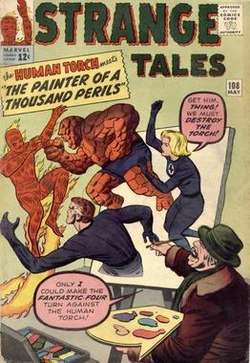Painter (comics)
Wilhelm van Vile, better known as The Painter, is a fictional supervillain appearing in American comic books published by Marvel Comics. The character was created by plotter Stan Lee, writer Robert Bernstein and artist Jack Kirby. He first appeared in Strange Tales #108 (1963).
| Painter | |
|---|---|
 Strange Tales #108 (May 1963): The Painter debuts. Cover art by Jack Kirby | |
| Publication information | |
| Publisher | Marvel Comics |
| First appearance | Strange Tales #108 (May, 1963) |
| Created by | Stan Lee (writer) Robert Bernstein (scripter) Jack Kirby (artist) |
| In-story information | |
| Full name | Wilhelm van Vile |
| Team affiliations | Avant Guard |
| Notable aliases | Painter of 1000 Perils |
| Abilities | Matter manipulation, superhuman speed |
Publication history
The Painter's premiere in Strange Tales #108 (May 1963) was a collaboration between editor and story-plotter Stan Lee, script-writer Robert Bernstein, and story-artist Jack Kirby, with inking done by Dick Ayers and Terry Szenics in charge of lettering. The story is republished in Human Torch #8 (November 1975).[1] The character is re-imagined by Pierce Askegren in his 1996 work The Ultimate Super-Villains, edited by Lee and published by Byron Preiss.[2]
Fictional character biography
Origins
Manhattan-based Wilhelm van Vile, an aspiring painter, attempts to pass off counterfeit paintings as the real deal. However, he makes many obvious mistakes when producing these fake works (such as coloring the boy in The Blue Boy green). Van Vile is promptly sent to jail.[3]
1960s
After being released, van Vile embarks on a cash-counterfeiting career but he once again does not heed major details. Johnny Storm easily spots his mistakes and throws him back into prison. Tunneling through a crevice in his prison cell's flooring, he finds an underground sanctuary, in which are mystical paints left behind by extraterrestrials. Van Vile discovers that whatever he creates with these paints will come to life. Forming an alliance with a number of small-time criminals, including Scar Tobin, van Vile adopts the nom de guerre of The Painter of 1000 Perils, or The Painter in short. He then exploits his new-found powers to exact revenge against Johnny Storm.[3]
Storm initially struggles to match the Painter's attacks. However, he later outsmarts the Painter by producing a double of himself, which the villain assumes is the real one. The real Storm takes the opportunity to destroy the Painter's magical paints.[3]
Return and death
The Painter regains his supervillain abilities some time later and comes under the influence of a multitude of insects which inhabit his body.[4] Using unspecified means, he takes over the wills of Bora and Spark and sends them to antagonise Spider-Man and Johnny Storm respectively. Collaboratively, he, Spark and Bora comprise "Avant Guard", a supervillain team.[5] When they lose and the situation goes stale, the Painter turns the two mutants into portraits and apparently kills himself by means of bodily explosion.[6]
Resurrection
Somehow the Painter is revived (or it could be presumed that it was a double who died previously), and he is seen imprisoned in a supervillain detainment facility, among numerous other foes who go against Spider-Man after being freed from their cells. Dressing up as Morlun, the Painter is swiftly defeated without much challenge.[7]
Powers and abilities
Strictly speaking, the Painter does not possess any superpowers, although he is a considerably skilled artist; he has cited himself as the "greatest painter on Earth".[8] It is his enchanted paints that allow him to paint inanimate matter to life. These creations can be erased from existence if he desires so. On top of that, the paints grant him superhuman speed when painting.[8]
Other versions
The Ultimate Super-Villains
Having spent many years behind bars, the Pierce Askegren version of the Painter decides to turn over a new leaf and finds a job as a professional illustrator. He is confronted by an aged Scar Tobin, who demands that the Painter surrender his sorcerous paints. The Painter does not relent and fights back with many of his doubles. It is later revealed that the Painter has not forsaken his criminal life, but instead has been keeping a low profile.[2]
See also

References
- Human Torch 8 (November 1975), New York City: Marvel Comics
- Stan Lee (1996). The Ultimate Super-Villains. Byron Preiss Multimedia Company. ISBN 978-1-57297-113-4.
- Stan Lee and Robert Bernstein (w), Jack Kirby (a). "Painter of a Thousand Perils!" Web of Spider-Man 108 (May 1963), New York City: Marvel Comics
- Tony Isabella (w), Alex Saviuk (p), Keith Williams (i). "Cold Hands, Warm Art" Web of Spider-Man 75 (April 1991), New York City: Marvel Comics
- Tony Isabella (w), Alex Saviuk (p), Keith Williams (i). "Art and Soul" Web of Spider-Man 74 (March 1991), New York City: Marvel Comics
- Tony Isabella (w), Alex Saviuk (p), Keith Williams (i). "Art's Desire" Web of Spider-Man 76 (May 1991), New York City: Marvel Comics
- Kevin Shinik (w), Aaron Kuder (p), Aaron Kuder (i). Avenging Spider-Man 13 (December 2012), New York City: Marvel Comics
- Marvel Legacy: The 1960s–1990s Handbook. Marvel Comics. 2007. p. 39. ISBN 9780785120827.
External links
- Painter (comics) at the Comic Book DB (archived from the original)
- Painter at The Appendix to the Handbook of the Marvel Universe